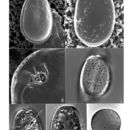Toxicity
provided by Harmful Phytoplankton Project
P. lima produces a number of toxic substances: prorocentrolide (Torigoe et al. 1988); diarrhetic shellfish poison (DSP) toxins (Yasumoto et al. 1987); okadaic acid (OA) (Murakami et al. 1982); dinophysistoxins-1 (DXT1) (Marr et al. 1992; Morton & Tindall, 1995); dinophysistoxins-2 (DXT2) (Hu et al. 1993); and dinophysistoxins-4 (DXT4) (Hu et al. 1995).
- bibliographic citation
- Guide to UK Coastal Planktonic Ciliates © 2001 DJS Montagnes, University of Liverpool http://www.liv.ac.uk/ciliate/
- author
- David J.S. Montagnes
Distribution
provided by Harmful Phytoplankton Project
World-wide distribution, neritic and estuarine, benthic/epiphytic (Faust et al. 1999), sand dwelling, can be tychoplanktonic (Steidinger & Tangen 1996), attached to the surface of red and brown algae and floating mangrove detritus.
- Morton SL & Tindall DR 1995. Morphological and biochemical variability of the dinoflagellate Prorocentrum lima isolated from three locations at the Heron Island, Australia. J. Phycol.31: 914-921.
- Faust MA 1993b. Sexuality in a toxic dinoflagellate, Prorocentrum lima. In: T.J. Smayda & Y. Shimizu eds., Phytoplankton Blooms in the Sea, Elsevier, Amsterdam, pp. 121-126.
- Faust MA & Gulledge RA 2002. Identifying Harmful marine Dinoflagellates. Contributions from the United States Herbarium, Smithsonian Institution, 42: 1-144, Pl.48.
- Hu T, Curtis Walter JA & Wright JLC 1995. Identification of DTX-4, a new water-soluble phosphatase inhibitor from the toxic dinoflagellate Prorocentrum lima. J. Chem. Soc. Chem. Comm. 5: 597-599.
- Faust MA 1993a. Alternate asexual reproduction of Prorocentrum lima in cultures pp. In: T.J. Smayda & Y. Shimizu eds., Toxic Phytoplankton Blooms in the Sea, Elsevier, Amsterdam, pp. 115-120.
- Marr JC, Jackson A & McLachlan JL 1992. Occurrence of Prorocentrum lima, a DSP toxin-producing species from the Atlantic coast of Canada. J. Appl. Phycol. 4: 17-24.
- Faust MA 1991. Morphology of ciguatera-causing Prorocentrum lima (Pyrrophyta) from widely differing cites. J. Phycology 27: 642-648.
- Faust MA, Larsen J and Moestrup Ø 1999. ICES Identification Leaflets for Plankton. Potentially Toxic Phytoplankton: 3. Genus Prorocentrum (Dinophyceae). International Council for the Exploration of the Sea, pp. 1-24.
- Murakami YY, Oshima & T. Yasumoto. 1982. Identification of okadaic acid as a toxic component of a marine dinoflagellate Prorocentrum lima. Bull. Jpn. Soc. Sci. Fish. 48: 69-72.
- bibliographic citation
- Guide to UK Coastal Planktonic Ciliates © 2001 DJS Montagnes, University of Liverpool http://www.liv.ac.uk/ciliate/
- author
- David J.S. Montagnes
Diagnostic Description
provided by Harmful Phytoplankton Project
Cell armored, photosynthetic with two chloroplasts and pusules, a centrally located pyrenoid and a posterior nucleus are present.
- bibliographic citation
- Guide to UK Coastal Planktonic Ciliates © 2001 DJS Montagnes, University of Liverpool http://www.liv.ac.uk/ciliate/
- author
- David J.S. Montagnes
Habitat
provided by Harmful Phytoplankton Project
Temperature 8-32ºC; Salinity 10-34 PSU
- bibliographic citation
- Guide to UK Coastal Planktonic Ciliates © 2001 DJS Montagnes, University of Liverpool http://www.liv.ac.uk/ciliate/
- author
- David J.S. Montagnes
Reproduction
provided by Harmful Phytoplankton Project
Cell reproduction has three different forms: 1) asexual by binary fission; 2); alternate asexual reproduction in which a chain of 4-32 cell pairs is enclosed within a thin-walled cyst (Faust 1993a); and 3) sexual reproduction involves the conjugation of isogamus gametes, and the formation of a large hypnozygote (resting cyst) (Faust 1993b).
- bibliographic citation
- Guide to UK Coastal Planktonic Ciliates © 2001 DJS Montagnes, University of Liverpool http://www.liv.ac.uk/ciliate/
- author
- David J.S. Montagnes
Behavior
provided by Harmful Phytoplankton Project
Cell moves by two dissimilar flagella inserted epically: one flagellum is transverse (provides direction) and the longitudinal flagellum (provides direction) for propelling cells in the water; both flagella emerges from the flagellar pore.
- bibliographic citation
- Guide to UK Coastal Planktonic Ciliates © 2001 DJS Montagnes, University of Liverpool http://www.liv.ac.uk/ciliate/
- author
- David J.S. Montagnes
Comprehensive Description
provided by Harmful Phytoplankton Project
P. lima is an armored, marine, benthic dinoflagellate species with world wide distribution. It produces several toxins. Cell oval in valve view; broad in the middle region, narrow at the anterior end; cell size 22-50 µm long and 20-28 µm wide; both valves concave; surface smooth; valve center devoid of pores; marginal pores useful diagnostic feature of this species from the other species in the Prorocentrum genus; periflagellar area on the right valve is a shallow V-shaped depression of 8 plates and 2 pores: larger flagellar pore(F) and smaller auxiliary pore (A); both valves interiorly indented, left valve margin has a flattened apical ridge that borders the periflagellar area. Cells are slow swimmers.
- bibliographic citation
- Guide to UK Coastal Planktonic Ciliates © 2001 DJS Montagnes, University of Liverpool http://www.liv.ac.uk/ciliate/
- author
- David J.S. Montagnes

